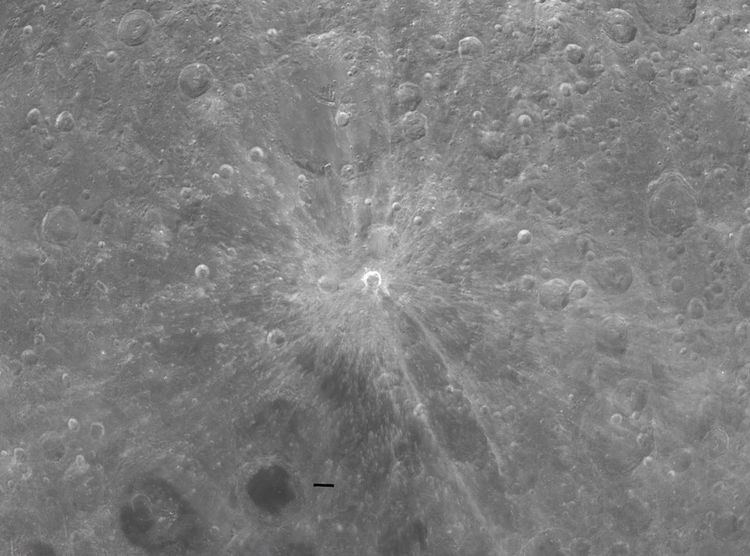Diameter 22 km Colongitude 258° at sunrise | Depth Unknown | |
 | ||
Giordano Bruno is a 22 km lunar impact crater on the far side of the Moon, just beyond the northeastern limb. At this location it lies in an area that can be viewed during a favorable libration, although at such times the area is viewed from the side and not much detail can be seen. It lies between the craters Harkhebi to the northwest and Szilard to the southeast.
When viewed from orbit, Giordano Bruno is at the center of a symmetrical ray system of ejecta that has a higher albedo than the surrounding surface. The ray material extends for over 150 kilometers and has not been significantly darkened by space erosion. Some of the ejecta appears to extend as far as the crater Boss, over 300 km to the northwest. The outer rim of the crater is especially bright, compared to its surroundings. To all appearances this is a young formation that was created in the relatively recent past, geologically speaking. The actual age is unknown, but is estimated to be less than 350 million years.
This feature was named after the Italian philosopher Giordano Bruno.
Formation
Five monks from Canterbury reported to the abbey's chronicler, Gervase, that shortly after sunset on June 18, 1178, (25 June on the proleptic Gregorian calendar) they saw "the upper horn [of the moon] split in two". Furthermore, Gervase writes:
From the midpoint of the division a flaming torch sprang up, spewing out, over a considerable distance, fire, hot coals and sparks. Meanwhile the body of the Moon which was below writhed, as it were in anxiety, and to put it in the words of those who reported it to me and saw it with their own eyes, the Moon throbbed like a wounded snake. Afterwards it resumed its proper state. This phenomenon was repeated a dozen times or more, the flame assuming various twisting shapes at random and then returning to normal. Then, after these transformations, the Moon from horn to horn, that is along its whole length, took on a blackish appearance.
In 1976, the geologist Jack B. Hartung proposed that this described the formation of the crater Giordano Bruno.
Modern theories predict that a (conjectural) asteroid or comet impact on the Moon would cause a plume of molten matter rising up from the surface, which is consistent with the monks' description. In addition, the location recorded fits in well with the crater's location. Additional evidence of Giordano Bruno's youth is its spectacular ray system: because micrometeorites constantly rain down, they kick up enough dust to quickly (in geological terms) erode a ray system, so it can be reasonably hypothesized that Giordano Bruno was formed during the span of human history, perhaps in June 1178.
However, the question of the crater's age is not that simple. The impact creating the 22-km-wide crater would have kicked up 10 million tons of debris, triggering a week-long, blizzard-like meteor storm on Earth – yet no accounts of such a noteworthy storm of unprecedented intensity are found in any known historical records, including the European, Chinese, Arabic, Japanese and Korean astronomical archives. This discrepancy is a major objection to the theory that Giordano Bruno was formed at that time.
This raises the question of what the monks saw. An alternative theory holds that the monks just happened to be in the right place at the right time to see an exploding meteor coming at them and aligned with the Moon. This would explain why the monks were the only people known to have witnessed the event; such an alignment would only be observable from a specific spot on the Earth's surface.
